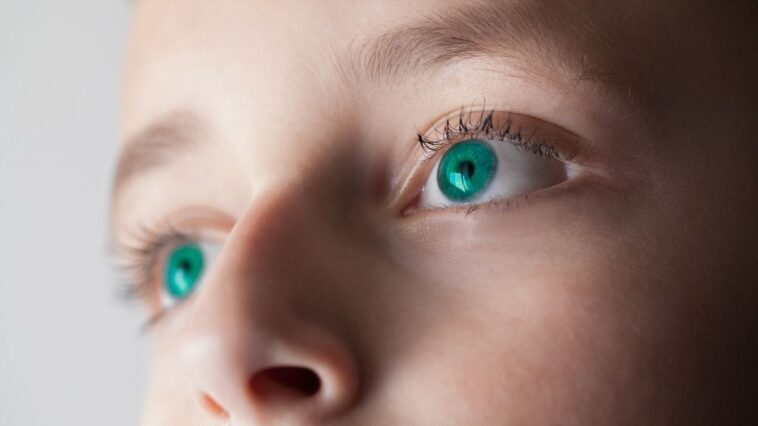What is The Rarest Eye Color Worldwide?
Eye color is a fascinating aspect of human biology, and its rarity has captured the interest of many people. While the most common eye color worldwide is brown, a few eye colors are considered rarer than others.
Green eyes are caused by a combination of factors, including a low amount of melanin in the front layer of the iris, a yellowish pigment called lipochrome, and the scattering of light that occurs in the iris.
Green eyes are believed to be the rarest eye color worldwide, with only about 2% of the world’s population having green eyes. Green eyes are most commonly found in people of Northern and Central Europe and some parts of the Middle East. However, it’s important to note that green eyes can also be found in other populations, including some Native American and African groups.
Blue eyes are also relatively rare, with only about 8% of people having blue eyes. Blue eyes are caused by a lack of pigmentation in the front layer of the iris, which allows the light to reflect off the back layer of the iris and give the eyes a blue color. Blue eyes are most commonly found in people of European ancestry, particularly those of Northern and Eastern European descent.
Hazel eyes are another eye color that is considered to be relatively rare, with only about 5-8% of people having hazel eyes. Hazel eyes are a combination of brown, green, and or blue, and their exact color can vary depending on lighting conditions and other factors. Hazel eyes are most commonly found in people of European descent, particularly Mediterranean or Middle Eastern ancestry.
Amber eyes are a golden or yellowish-brown color most commonly found in people of Asian or South American descent. Other rare eye colors include amber, violet, and red. Violet eyes are extremely rare and are thought to be caused by a combination of a lack of melanin and the scattering of light in the iris. Red eyes are also extremely rare and are usually caused by albinism, a genetic condition that results in little or no melanin production in the body.
In conclusion, while green eyes are often considered the rarest eye color worldwide, it’s important to note that eye color can vary widely depending on geographic location, ethnicity, and other factors. Blue and hazel eyes are also relatively rare, and other eye colors, such as amber, violet, and red, are extremely rare. Ultimately, the rarity of eye color is less important than the beauty and diversity of the human population.
What are the Different Countries With the Rarest Eye Colors?
Eye color is determined by a complex interplay of genetic and environmental factors, and its distribution varies widely across different populations and geographic regions. While the most common eye color worldwide is brown, there are several countries where rare eye colors such as green, blue, and hazel are more prevalent. Here are some examples:
- Ireland: Ireland is often associated with green eyes, and for a good reason. Studies have shown that up to 86% of the Irish population has blue or green eyes, with green being the more common. This is believed to be due to genetic factors and the country’s northern latitude, which may have led to a higher prevalence of light-colored eyes.
- Finland: Finland is another country where green eyes are relatively common. Studies have shown that up to 29% of the Finnish population has green eyes, with blue being the second most common color. This is believed to be due to a genetic mutation more common in the Finnish population than in other groups.
- Denmark: Denmark is another country where blue eyes are relatively common, with up to 80% of the population having blue eyes. This is believed to be due to genetic factors and the country’s northern latitude, which may have led to a higher prevalence of light-colored eyes.
- Sweden: Sweden is another country where blue eyes are relatively common, with up to 79% of the population having blue eyes. This is believed to be due to genetic factors and the country’s northern latitude, which may have led to a higher prevalence of light-colored eyes.
- Estonia: Estonia is a country where blue eyes are particularly prevalent, with up to 99% of the population having blue or gray eyes. This is believed to be due to a genetic mutation more common in the Estonian population than in other groups.
- Lebanon: Lebanon is a country where green eyes are relatively common, with up to 35% of the population having green or hazel eyes. This is believed to be due to genetic factors and the country’s location in the Middle East, which has historically been a crossroads of different cultures and ethnic groups.
- Russia: Russia is a country where blue eyes are relatively common, particularly in the northern and central regions. Studies have shown that up to 80% of the Russian population has blue or gray eyes, with green and brown being less common.
It’s important to note that eye color can vary widely within a given country or population, and the prevalence of rare eye colors can change over time due to various factors such as migration, intermarriage, and changes in environmental conditions. However, these are some examples of countries where rare eye colors are relatively common.
How do Genetic Traits Affect a Person’s Eye Color?
Genetic traits play a significant role in determining a person’s eye color. The amount and type of pigmentation determine eye color in the iris, the colored part of the eye. Two main types of pigments in the iris contribute to eye color: melanin and lipochrome. Melanin is responsible for brown and black colors, while lipochrome contributes to green and blue colors.
The genes that control eye color are located on chromosomes, which are structures in the nucleus of a cell that contain DNA. Several genes can influence eye color, but the two most important ones are OCA2 and HERC2. The OCA2 gene controls the production and distribution of melanin in the iris, while the HERC2 gene regulates the expression of the OCA2 gene.
Different versions of these genes, known as alleles, can lead to different levels and types of pigmentation in the iris, resulting in different eye colors. For example, people with two copies of the OCA2 allele associated with brown eyes typically have dark brown or black eyes. In comparison, people with two copies of the allele associated with blue eyes have light blue eyes. People with a combination of different alleles may have green, hazel, or gray eyes.
Eye color inheritance is a complex process that depends on many factors, including the interaction between multiple genes and environmental factors, such as exposure to light. Generally, however, eye color is inherited in a predictable pattern known as Mendelian inheritance. This means that specific alleles are dominant over others and that the likelihood of a particular eye color depends on the combination of alleles inherited from both parents.
Genetics plays a significant role in determining a person’s eye color. However, the inheritance of eye color is complex and can vary widely between individuals, depending on the specific combination of genes inherited from their parents.
What are Eye Color Percentages Around the World?
Eye color percentages worldwide vary widely depending on the population and ethnic group. Here are some general estimates:
- Brown Eyes: Brown eyes are the most common eye color worldwide and are particularly prevalent in populations of African, Asian, and Native American descent. In these populations, up to 90% of individuals have brown eyes. In European populations, around 70-80% of individuals have brown eyes.
- Blue Eyes: Blue eyes are relatively rare in most populations and are most commonly found in populations of European descent. In these populations, up to 80% of individuals have blue or green eyes, with blue being the less common of the two. Blue eyes are much less common in other populations, such as those of African and Asian descent.
- Green Eyes: Green eyes are rarer than brown eyes but more common than blue eyes. They are most commonly found in populations of northern and central European descent. Up to 20% of individuals in these populations have green or hazel eyes.
- Hazel Eyes: Hazel eyes are less well-defined and range from greenish-brown to blue-gray. They are most commonly found in populations of northern and central European descent and are thought to be the result of complex interactions between multiple genetic and environmental factors.
These percentages are only estimates and may vary depending on the source and methodology used to collect the data. It is important to note that eye color is not determined by a single gene but rather by a complex interaction of multiple genes and environmental factors. As a result, eye color can vary even within the same family.
Eye Color and Changes With Age
While eye color is mainly determined by genetics, it can also change over time. In some cases, the change in eye color can be a sign of a medical condition.
Eye color is often not fully developed in infants and can change during the first year of life. This is because the amount and type of pigments in the iris can increase or decrease during this time.
As people age, the amount of pigments in the iris can also change, which can cause a change in eye color. This is often seen in people with lighter-colored eyes, such as blue or green, whose eyes may become darker as they age.
In addition to changes in pigments, other factors, such as lighting conditions and emotions, can also affect the appearance of eye color. For example, a person’s eyes may appear brighter or darker depending on the lighting in a room or may appear to change color slightly based on their emotional state.
How to protect your eyes and keep them healthy for longer?
You can do several things to protect your eyes and keep them healthy for longer. Here are some tips:
- Wear sunglasses: Sunglasses protect your eyes from harmful ultraviolet (UV) radiation from the sun, which can lead to cataracts, macular degeneration, and other eye problems. Look for sunglasses that block at least 99% of UV-A and UV-B radiation.
- Eat a healthy diet: A diet rich in fruits, vegetables, and omega-3 fatty acids can help keep your eyes healthy. Foods like leafy greens, citrus fruits, fish, nuts, and seeds are particularly beneficial for eye health.
- Avoid smoking: Smoking can increase your risk of cataracts, macular degeneration, and other eye problems. If you smoke, quitting can help protect your eyes and improve your overall health.
- Take regular breaks from screens: Prolonged exposure to digital screens can cause eye strain, dryness, and other problems. To reduce your risk, take frequent breaks from screens and often blink to keep your eyes lubricated.
- Exercise regularly: Exercise can help improve blood flow to your eyes, keeping them healthy. Aim for at least 30 minutes of moderate-intensity exercise most days of the week.
- Get regular eye exams: They can help detect eye problems early when they are most treatable. Make sure to see an eye doctor at least once every two years or more if you have a family history of eye problems or other risk factors.
By following these tips, you can help protect your eyes and keep them healthy for longer. Always consult your eye doctor if you have any concerns about your eye health or experience changes in your vision.






